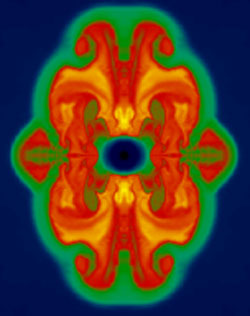Supernovae Surprise

A supercomputer simulation of a large, collapsing star shows violent convection (orange and red) in the neutrino-heated region behind the expanding shock wave. But despite sophisticated modeling, this star didn't blow up. Image Credit: Max-Planck-Institute for Astrophysics
There's no avoiding the tragic end of a large star's life: it dies in a catastrophic explosion called a supernova. But in the most complete computer simulation to date, those final moments don't end with a bang. Ignorance about the physics of neutrinos is the main problem. Researchers at the Max-Planck-Institute for Astrophysics were surprised not to get an explosion, even though they accounted for neutrinos more accurately than previous attempts had. Only a better understanding of neutrino behavior in the extreme environment of a dying star is likely to lead to explosive virtual supernovae.
Read more about this research at Physical Review Focus.
Text courtesy of Physical Review Focus.











